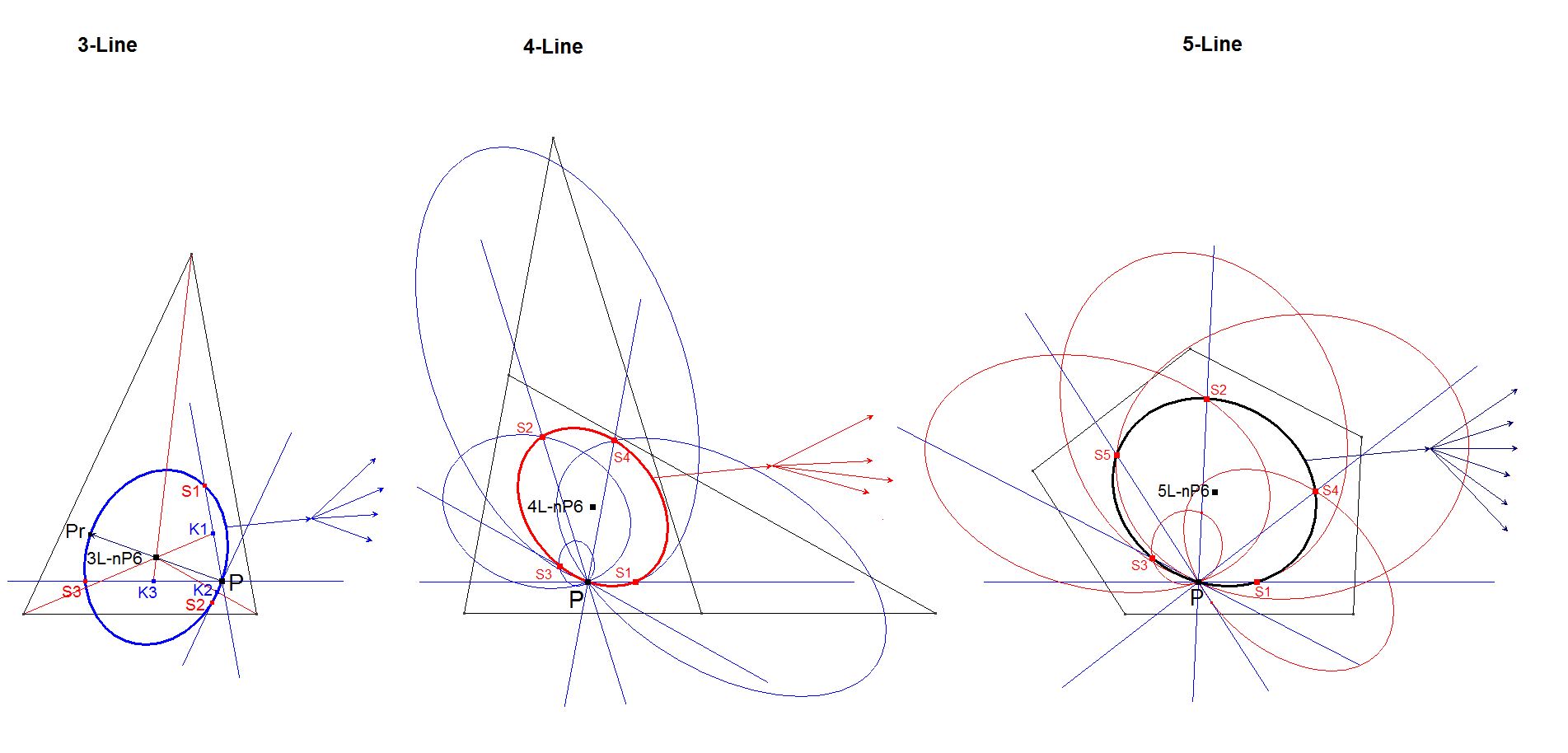nL-n-P6: nL-Least Squared Distances Point
nL-n-P6 is the unique point in an n-Line with the Least Sum of Squared Distances to its n Lines.
nL-n-P6 can be constructed in a recursive way:

The nL-n-P6 point can be constructed because in an n-Line the points with an equal sum of squared distances lie on an ellipse. See [34], QFG #1617, #1622.
This ellipse with a Fixed Sum of Squared Distances is called here an FSD-ellipse and when passing through P it is called the P-FSD-ellipse. The point with Least Sum of Squared Distances is the center of any FSD-ellipse.
A P-FSD-ellipse can be constructed by drawing lines in an n-Line through P parallel to the n Lines. Now on each of these parallel lines there will be a second point next to P with the same fixed sum of squared distances also lying on the P-FSD-ellipse. When we find 5 of these second points we have defined a conic and this conic should be the P-FSD-ellipse. Actually 4 points will be enough for construction because P is per definition also on the conic.
Per level a P-FSD-ellipse is constructed that will be transferred to the next level. The center of the P-FSD-ellipse is nL-n-P6 for that level.
Construction in a 3-Line (triangle)
This is the lowest level which differs from the general case.
- Let P be some arbitrary point and K be the Symmedian Point X(6) in a triangle. X(6) is the nL-Least Squares Point of a triangle.
- Draw lines Lp1,Lp2,Lp3 through P parallel to the sidelines L1,L2,L3,
- Let K1,K2,K3 be the intersection points of Lp1,Lp2,Lp3 and the resp. symmedians through the triangle vertices L2^L3, L3^L1, L1^L2.
- Let S1,S2,S3 be the reflections of P in K1,K2,K3.
- Let Pr be the reflection of P in K.
- The conic through P, Pr, S1, S2, S3 will be the P-FSD-ellipse.
In a similar way we can construct a P-FSD-ellipse in a 4-Line (quadrilateral).
- Let L1,L2,L3,L4 be the 4 defining lines of the 4-Line.
- Draw lines Lp1,Lp2,Lp3,Lp4 through arbitrary point P parallel to the sidelines L1,L2,L3,L4.
- We are searching for the second point on Lp1 with same sum of squared distances to L1,L2,L3,L4 as P has. When we vary P on Lp1 at least the distance to L1 is fixed. So we have to find the point with fixed sum of squared distances to L2,L3,L4. This is the FSD-triangle problem like described here before. So construct the P-FSD-ellipse wrt triangle L2.L3.L4. Let S1 be the 2nd intersection point of this P-FSD-ellipse with Lp1. S1 has the same fixed sum of squared distances to L1,L2,L3,L4 as P.
- Accordingly we can construct S2, S3, S4.
- The conic through P, S1, S2, S3, S4 will be the P-FSD-ellipse in a 4-Line (quadrilateral).
- The center of this ellipse is QL-P26 indeed. See EQF.
In a similar way we can construct a P-FSD-ellipse in a 5-Line (pentalateral).
- Let L1,L2,L3,L4,L5 be the 5 defining lines of the 5-Line (pentalateral).
- Draw lines Lp1,Lp2,Lp3,Lp4,Lp5 through arbitrary point P parallel to the sidelines L1,L2,L3,L4,L5.
- We are searching for the second point on Lp1 with same sum of squared distances to L1,L2,L3,L4,L5 as P has. When we vary P on Lp1 at least the distance to L1 is fixed. So we have to find the point with fixed sum of squared distances to L2,L3,L4,L5. This is the FSD-triangle-problem for a 4-Line like described here before. So construct the P-FSD-ellipse wrt quadrilateral L2.L3.L4.L5. Let S1 be the 2nd intersection point of this P-FSD-ellipse with Lp1. S1 has the same fixed sum of squared distances to L1,L2,L3,L4,L5 as P.
- Accordingly we can construct S2, S3, S4, S5.
- The conic through P, S1, S2, S3, S4 will be the P-FSD-ellipse in a 4-Line (quadrilateral). It will appear that S5 is also on the conic.
- The center of this ellipse will be the LSD-point of a 5-Line.
In a recursive way P-FSD-ellipses can be constructed in every n-Line (n>2) and the center of this P-FSD-ellipse will be the LSD-points of the n-Line.
Another Construction
Coolidge describes in Ref-25 a general method for constructing this point in an n-Line.
In this picture an example is given in a 4-Line, where nL-n-P6 = QL-P26.

This construction is a modified version of the construction of Coolidge.
- Let O (origin), A and B be random non-collinear points.
- Go = Quadrangle Centroid of the projection points of O on the n basic lines of the Reference n-Line.
- Ga = Quadrangle Centroid of the projection points of O on the n lines through point A parallel to the n basic lines of the Reference Quadrilateral.
- Gb = Quadrangle Centroid of the projection points of O on the n lines through point B parallel to the n basic lines of the Reference Quadrilateral.
- Let Sa = Ga.Go ^ O.Gb and Sb = Gb.Go ^ O.Ga.
- Construct A1 on line O.A such that Sa.Ga : Ga.Go = O.A : A.A1.
- Construct B1 on line O.B such that Sb.Gb : Gb.Go = O.B : B.B1.
- Construct P such that O.A1.P.B1 is a parallelogram and where O and P are opposite vertices. P is the Least Squares Point nL-n-P6.
Correspondence with ETC/EQF
- When n=3, then nL-n-P6 = X(6).
- When n=4, then nL-n-P6 = QL-P26.
Estimated human page views: 366
